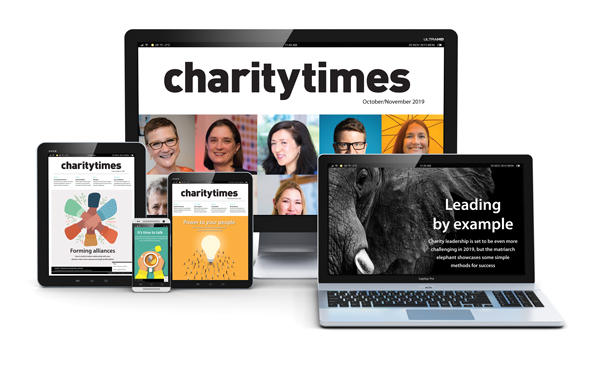The Covid-19 health crisis has transformed society and the charity sector has been no exception.
At the start of the pandemic, in March 2020, charities were forced to swiftly pivot public fundraising and vital frontline services online, to maintain social distancing guidelines.
Digital has further helped charities in a raft of ways, in particularly continue holding meetings, conferences and events.
The type of volunteers required to implement charities’ increasing reliance on online operations also changed throughout 2020.
In addition, staff were sent home as offices shut their doors. Many charity workers have spent months working in spare rooms and from their kitchen table if necessary.
The health crisis also raised several issues that some in the sector where already looking to tackle. This has included supporting the mental health and emotional wellbeing of staff and ensuring recruitment, service delivery and communications is diverse, and racism is tackled.
But rather than return to pre-2020 ways of working, evidence is emerging that such trends look set to continue long after UK society has re-opened and lockdown eases.
Here we outline some of the major trends among charities during the pandemic that look set to shape the sector for years to come.
Boost for flexible working
Working from home became the ‘new normal’ for thousands of charity workers during the health crisis due to social distancing.
But as offices and centres reopen, many charities are looking to continue giving staff the chance to work from home through blended and flexible working arrangements.
These are where staff can work part or all of the time at home, remotely or in the office. Software such as Zoom, Slack and Microsoft Teams has been vital to promoting blended working arrangements.
Staff have driven this demand. While working from home amid the pandemic many found they had a better work life balance, with less time spent commuting and more time with their family, including being available for school collections.
According to Blackbaud’s Future of Work report earlier this year, eight out of ten charity workers back working from home. For many this is part of a flexible arrangement sharing their time between home and office.
Charities are also seeing the benefits, in terms of productivity from happier, healthier staff. They are also saving money on premises, with less staff needed in their offices at any one time.
According to research by insurer Ecclesiastical one in five charities are looking at office closures. Almost half said they are considering changing their long-term office arrangements.
Among charity sector organisations already putting on place long term flexible working arrangements is Directory of Social Change, which has moved its full-time staff to a four day week, giving them all longer weekends.
Dramatic increase in online donations
The proportion of charity donors who are giving digitally rocketed during the pandemic, as people spent more time online at home and became increasingly digitally savvy.
The rise in the use of digital wallets via smart phones was a particular giving trend that is set to continue.
A report by WPNC released earlier this year found online giving doubled during the health crisis, matching the doubling of internet use over the same period.
WPNC also found the percentage of one-off donations made via ApplePay more than doubled, from 3.1% in 2019 to 7% in 2020.
The rise in digital wallets “is a consistent trend that has been going on during the last few years, and we expect to see new payment methods increase even more in the future”, said WPNC.
Its report also predicts long term growth in donations through voice, such as Amazon’s Alexa as well as through social media, in particular Facebook and Instagram.
Rise in digital service delivery
Charities have been swift to offer digital support options to beneficiaries amid the pandemic, due to social distancing curbs on face-to-face meetings and counselling.
This has included the use of video conferencing to offer one to one and group support.
Information and support via websites, chat bots and social media groups has also escalated.
Post pandemic, this digital support will continue, most likely as part of a suite of options for beneficiaries.
The need to reach more people is fuelling this, as demand for mental health support post-Covid increases.
New Philanthropy Capital is calling on funders to back ‘blended’ services that include digital and face-to-face support.
An NPC report released earlier this year says: “Digital services can be useful in many ways, but they will not suit everyone, so funders should make sure they are protecting offline, in-person options for those who need it.”
Lockdown has created new challenges for charities. Digital services can be useful in many ways, but they will not suit everyone, so funders should make sure they are protecting offline, in-person options for those who need it. #ChildrensMentalHealthWeek https://t.co/hYrT0KeQcC
— NPC (@NPCthinks) February 3, 2021
Recruiting tech savvy volunteers
A long-term focus in the charity sector on online support and remote working means the nature of volunteering has changed.
Increasingly charities are looking for tech-savvy young professionals to give up their time to help charities, often from their home.
There is still a need for volunteers to support communities in person. For example, The Scouts launched a recruitment campaign in May to tackle an exodus of 15,000 volunteers from its organisation.
But evidence is emerging that the search for volunteers with digital expertise will be increasingly needed long term.
In May the Covid-19 Voluntary Sector Impact Barometer found that charities are
Where they are recruiting, charities are increasingly asking for digital and technical skills due to the increase in online and remote working.
The average age of volunteers is also falling, the Impact Barometer, suggests.
The Impact Barometer has called for charities to offer worthwhile digital opportunities to ensure they can attract volunteers. Many charities are already doing this, it found.
“Working digitally, where geography and for some roles set times are no longer as critical, has allowed organisations to experiment with different types of volunteering,” the research says.
Holding more virtual meetings...
Virtual conferencing, events and fundraising activity has been successfully deployed by charities amid the health crisis. When curbs on social distancing are removed, such online options are set to continue.
A key factor is ease and cost. Staff and stakeholders will continue to take part in online meetings without spending time travelling and incurring accommodation expenses.
In addition, charity professionals can easily attend virtual conferences from their desk.
…and staging more fundraising events online
Virtual fundraising has become increasingly innovative over lockdown, with charities successfully using live streaming and social media to engage donors and supporters.
This innovation is set to remain and become a regular fixture alongside traditional, face to face events.
Among the most high-profile events to utilise digital is this year’s London Marathon. This aims to combine its traditional, in person race in central London with a virtual element to allow people around the world to take part. It aims to involve 100,000 competitors in 2021 by combining traditional and virtual event planning.
Improving diversity
Prior to the pandemic many charities were becoming aware of the need to be better at tackling racism. This means improving equality, diversity and inclusion in their own organisation as well as among stakeholders and in the support they provide.
The health crisis shone a bigger spotlight on inequality and racism, with many in ethnic minority communities bearing the brunt of the pandemic as they are more likely to be in low paid, frontline roles and crowded housing.
The last year has seen a raft of charity organisations face some uncomfortable truths in tackling racism in their own ranks, including the NCVO, Barnardo’s, Christian Aid, Amnesty International UK and Girlguiding
Others have sought to tackle their historic links to slavery, such Joseph Rowntree charities.
This trend is set to continue, with more charities looking to address racism or face a backlash through inaction.
Boosting mental health support
Working remotely at home, redundancy, falling income and escalating demand have taken their toll on the emotional wellbeing of charity leaders and workers, amid the pandemic.
Frontline charity workers have been particularly impacted, supporting some of the world’s most vulnerable communities during the crisis.
Charities have already taken action to improve their support for staff and this is set to continue long term, with the mental health scars of the crisis set to last for many years to come.
Action already being taken includes setting up emotional support groups through social media as well as offering counselling and online help.
Such support is vital to avoid an exodus of charity leaders. According to Ecclesiastical around half of charity leaders have admitted they had been considering their future in the sector, as a result of increased mental health pressures.













Recent Stories